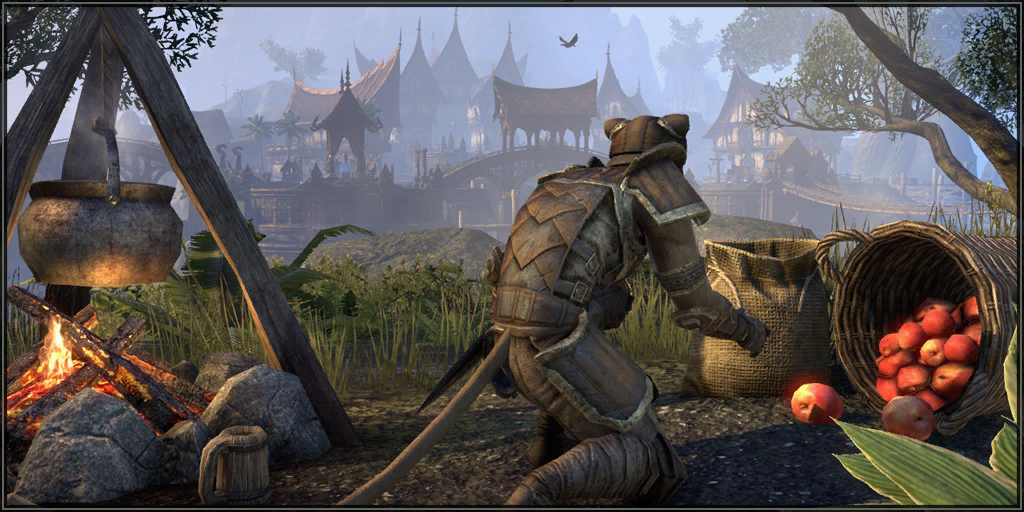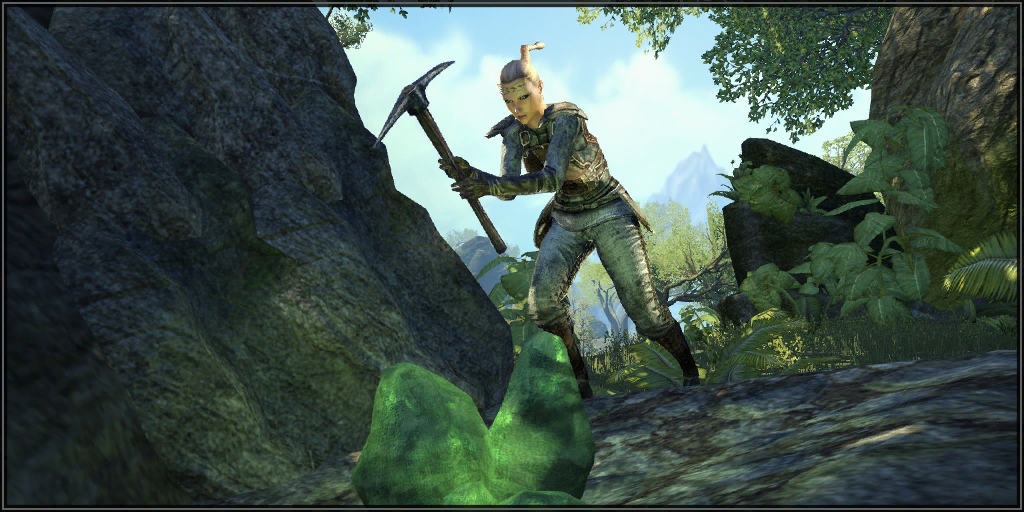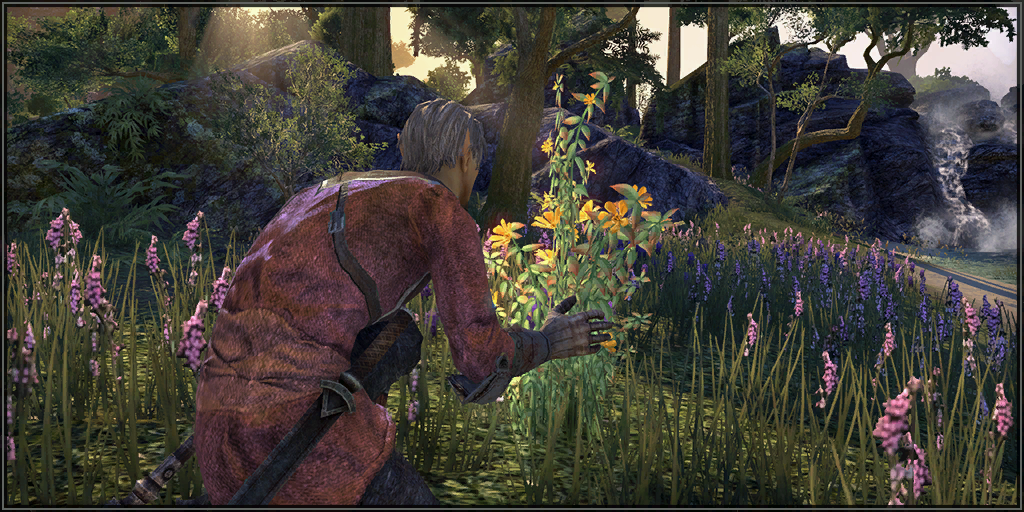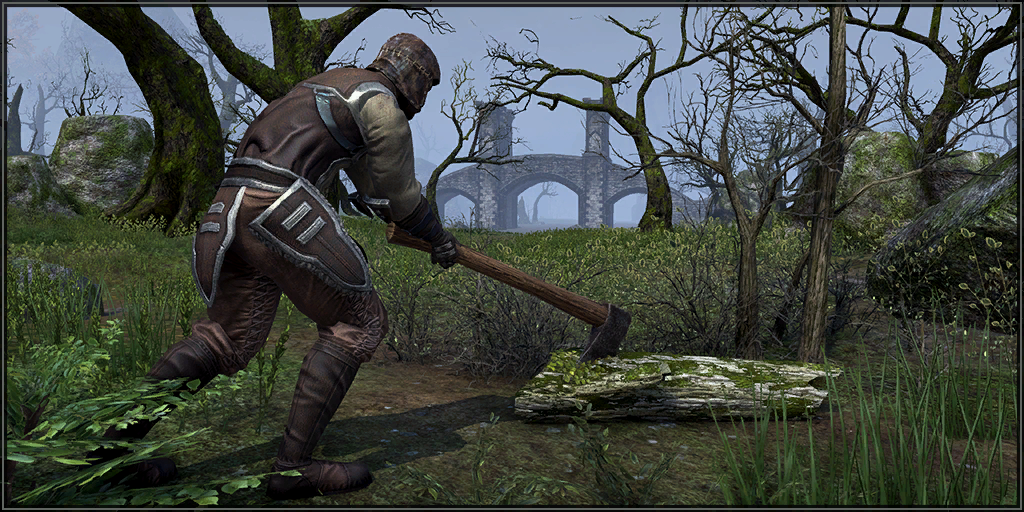Crafting - ESO

Alchemist
An Alchemist gathers natural reagents found growing in the world, and mixes them with solvents at an Alchemy Table to create potions and poisons. Particularly pure water will produce a potion, while various viscous oils can be used to produce poisons. The grade of the solvent will determine the potency of the product. Poisons are at their strongest when concentrated—the more effects that are present on a poison, the less potent each individual effect will become.All reagents have hidden traits which determine a product's effects. Similar traits from different reagents must be stacked to bring out their magical qualities. Each trait can be countered by another trait, and if the wrong reagents are mixed together they might cancel each other out. A skilled Alchemist experiments to find reagent combinations that offer the best results.Poisons that are crafted with positive effects, such as Restore Health, will drain that effect from the target to enhance the poisoner.

Enchanter
An Enchanter gathers runes found throughout the world. They can then use Enchanting Tables to assemble those runes into glyphs that can enhance items that are worn or wielded. The Help section on glyphs explains how these are used.Runes can also be extracted from glyphs by opening the extraction tab at an Enchanting Table. Choose a glyph from your inventory to perform an extraction. Remember that performing the extraction process will destroy the glyph.Enchanters create glyphs by combining runes of three different types: Potency, Aspect and Essence. Potency will determine the required level and strength of the resulting glyph, Aspect will determine its quality, and Essence will determine its magical effect. A skilled Enchanter will collect and combine any runes he finds in an effort to decipher their hidden language and unlock their magical properties.

Provisioner
A Provisioner collects recipes and ingredients found throughout the world to make a wide array of food and drink.Recipes, needed to learn how to make new types of food, can be found in chests, trunks and desks, as well as from other adventurers and sometimes even from fallen enemies.
Ingredients can be obtained a number of ways, including purchasing them, searching populated areas as well as various containers, killing animals, fishing, receiving hireling deliveries, and fulfilling Crafting Writs.When a Provisioner finds a new recipe they can learn it by using it from their inventory. This action will add it to their recipe book.
Provisioners create known food and drinks by utilizing one of the many usable cooking fires found throughout the world.
Foods give long term boosts to Health, Magicka or Stamina while Drinks improve their recovery rates.

Blacksmith
A Blacksmith mines the mountains of Tamriel for the metals they need to work their craft. Blacksmiths use these raw resources at a Blacksmithing Station—one of the many anvils commonly found in cities and towns throughout Tamriel. Here they can refine raw metals, improve existing items, research new traits, and deconstruct weapons and armor they have found throughout their journeys.A skilled Blacksmith will always seek to learn new techniques to better their skills at the forge. Finding special crafting books is the key to learning new racial styles, and researching traits allows for the creation of higher quality weapons and armor.
Clothier
A Clothier searches the land for plants that can be used to create cloth, and the hides of creatures that can be used to create leather. Clothiers use these materials at Clothing Stations—one of the many tannin tables found in cities and towns throughout Tamriel. Here they can refine their raw resources, improve existing items, research various traits, and deconstruct armor they have found throughout their journeys.Skilled Clothiers are always seeking to learn new techniques to better their skills at the tannin table. Finding special crafting books is the key to learning new racial styles, and researching traits allows for the creation of higher quality clothing and armor.
Woodworker
A Woodworker collects quality wood that can be used to craft elegant staves and shields. Woodworkers use these materials at Woodworking Stations—one of the many mills found in cities and towns throughout Tamriel. Here they can refine raw resources, improve existing items, research various traits, and deconstruct staves and shields they have found throughout their journeys.Skilled Woodworkers are always seeking to learn new techniques to better their skills at the mill. Finding special crafting books is the key to learning new racial styles, while researching traits allows for the creation of higher quality staves and shields.
Jewelry Crafting
A Jewelry Crafter mines, and works with, precious metals to craft rings and necklaces. They use these materials at Jewelry Crafting Stations, found in cities all over Tamriel. There, they can refine the precious metal dust they gather from seams, improve the quality of items, research new traits, and deconstruct the jewelry they have found in their adventures.Jewelry Crafting is available to players who have access to Summerset. Players who do not have access to Summerset can gather materials from seams, but cannot use Jewelry Crafting Stations to refine, craft, improve, or deconstruct.
Crafting: Creation
To create an item, or items, interact with a crafting station by pressing E. The Creation Menu will appear by default.Select the category of the item, or items, you want to create, in the upper right corner of the creation menu.
Once you have selected a category, use the left and right arrow buttons to view and select an item type.Choose a material to craft using the left and right arrow buttons, and the plus and minus buttons below the material to choose the level of the item, or items, you wish to craft.
Select a racial style for the items using the left and right arrow buttons. Initially, you will only be able to craft in the racial style of your character, but other racial styles can be unlocked.
Select a trait to add one of a variety of available enhancements to your items. Researching will unlock new traits.

Crafting: Improvement
To improve the quality of your items, interact with a crafting station by pressing the E key. Click the Improvement icon on the top bar of the crafting menu, then select the item category. A list of the items in your inventory that can be improved will appear.Double-click on the item you wish to improve and it will appear in the "Improve" slot in the center of the screen. The improvement material needed to improve the selected item's quality will appear beside it. Click the plus button beneath it to increase the amount, which will increase the chance that the improvement will be successful. When you are satisfied, press the R key to commit to the improvement.Crafting: Deconstruction
To extract materials and inspiration from items in your inventory that can be used for crafting, interact with a crafting station by pressing the E key.To extract from an item, click the Deconstruct icon on the top bar of the crafting menu. Then, select the category of items you wish to deconstruct. Click to select the items you wish to deconstruct, and press the R key to confirm the deconstruction.While any weapon or armor can be deconstructed, items with the Intricate trait will yield more inspiration and materials.
• Deconstruction will destroy the items.
Additionally, the Deconstruction Assistant can deconstruct Weapons, Apparel, Jewelry, or Glyphs items without the need for a crafting station.
Crafting: Refining
You cannot use most raw resources you obtain from gathering in crafting. You must first refine them into a usable material.To refine raw resources into materials that you can use for crafting, interact with a crafting station by pressing the E key. Then, click the Refine icon on the top bar of the crafting menu. Double-click the raw material you wish to refine, and press the R key to confirm the refinement.
By default, you will refine as much of the raw resource as you have, but you can chose to use less by decreasing the Quantity, next to the selected material to refine.You must have at least 10 of a raw resource to refine it. Durable raw resources will become 7 to 10 units of the refined material, while many other resources (such as Grains and Style Items) will become exactly one unit of refined material.
Some kinds of raw resources, such as Ore, may result in obtaining more than just their refined materials, depending on the passive crafting skills you've obtained and the Champion stars you've unlocked. You can obtain Style Items, Trait Items, and even Quality Boosters (such as Platings, Resins, Tannins, and Tempers).
Crafting: Filleting
You can't use raw fish you've caught while fishing in crafting. You must first fillet non-trophy fish into usable Provisioning ingredients.To fillet raw fish into Provisioning ingredients, interact with a provisioning station by pressing the E key. Then, click the Fillet icon on the top bar of the crafting menu. Select the raw fish you wish to fillet, and press the R key to confirm the fillet.
By default, you will fillet all of the raw fish of that type, but you can choose to fillet fewer fish by adjusting the number under Quantity, next to the fish you selected to refine.
Some fish provide an additional Provisioning resource, such as Perfect Roe.
Crafting: Research
Items with traits that can be researched will show next to the trait name in the item description.To research traits on weapon and armor types, interact with a crafting station by pressing E. Click on the top bar of the crafting menu, then select a trait research line using the left and right arrow buttons.If you have an item in your inventory that can be researched an indicator will appear under the selected trait line and the text next to the researchable trait will display "Researchable". Double-click on the item you wish to research and press E to confirm the research.
The research process takes time. This time will increase when multiple traits have been researched for a specific trait research line.
Crafting: Inspiration
Inspiration is crafting experience, which each tradeskill accumulates independently. Creating or deconstructing an item, performing research, learning a recipe or plan, or fulfilling a writ rewards you with Inspiration. Gaining enough Inspiration levels up that tradeskill. Inspiration is tracked with a progression bar in the upper left hand corner of the window with the name of the tradeskill.The higher level and quality of item being worked on, the more Inspiration is awarded, though reaching too far beyond your current level has diminishing returns. Deconstructing vendor items or your own creations yield significantly less Inspiration than items found from foes or other players' creations, while "intricate" items grant additional Inspiration.
The best way to gain Inspiration is through crafting writs found on crafting boards, which are accessible after the completion of the associated crafting certifications.
Crafting: Passive Abilities
Passive Abilities for crafting grant benefits to the associated tradeskill. When you gain enough Inspiration and level up your tradeskill, you may unlock the opportunity to spend skill points to purchase new or enhance current Passive Abilities.Half of the harvest nodes you encounter are based on your character level, while the other half are based on Passive Abilities that unlock higher level materials. These Passive Abilities also affect the accessibility of higher level writs.
Passive Abilities are always in effect.
Master Writs
Master Writs are a potential reward for completing high end, regular writs. These special Writs can ask for rare materials, very high-quality results, or specific motifs or item sets. Performing extensive tradeskill-specific actions such as doing research, learning recipes or motifs, translating runes, or identifying herbs makes Master Writs more likely to appear.Completing Master Writs rewards you with Writ Vouchers. These Vouchers are a currency, which you can view in the Currency tab. Use them to purchase special items, including housing decor, recipes, and motifs, from Rolis Hlaalu and Faustina Curio. They are found in Stormhaven, Deshaan, and Grahtwood.
Transmutation: Changing Traits
Through a Transmute Station, you can use crystals created through powerful events to fundamentally alter your items. This takes the form of changing the item's trait.There is a Transmute Station in the Brass Fortress in the Clockwork City. You may also acquire a Transmute Station for use in a home you own, or may visit friends' homes and use any Transmute Stations they possess.In order to change an item's trait, you must have researched the trait you wish to have on the type of item you wish to change.
Once an item's trait has been changed through Transmutation, it can no longer be used for research. The item also becomes bound to you, if it was not already, and can no longer be traded away.
Item Set Collection
Through the use of a Transmute Station, you can recreate the many Set Items that you've acquired while on your journey, even if you no longer have the original item in your possession.Adding an Item to your Collection
Dungeon, Trial, and Arena Set Items are automatically bound and added to your collection when they're acquired. Other Set Items (such as from overland content or a crafting station) may be added to your collection by equipping and binding the item.
Set Items are also added to your collection by destruction through Deconstruction, Research, Fencing, or other methods.
Viewing your Item Set Collection
You can view your Item Set Collection in the Collections menu, under the Sets heading.
Within this menu, you can view all of the Set Items you've collected, as well as seeing what Set Items you've yet to collect, and how much of each Set you've managed to find.Reconstructing Set Items
To reconstruct the Set Items in your Collection, you must visit a Transmute Station, such as the one found in the Brass Fortress of Clockwork City. There, you can use Transmute Crystals to reconstruct the items you know. The more items in a Set you know, the fewer Transmute Crystals you'll need!
When reconstructing a known Set Item, you can also use Booster materials to improve the item's quality above its baseline, just as you could with crafting. This is merely a convenience; there is no difference in the number of Boosters needed at one station versus another.
Help articles
68 articles
-

-

-

-

-

-

-

-

-

-

-

-

-

-

-

-

-

-

-

-

-

-

-

-

-

-

-

-

-

-

-

-

-

-

-

-

-

-

-

-

-

-

-

-

-

-

-

-

-

-

-

-

-

-

-

-

-

-

-

-

-

-

-

-

-

-

-

-

 Deutsch
Deutsch
 Français
Français
 Русский
Русский
 Español
Español

















































































































































































































































































































